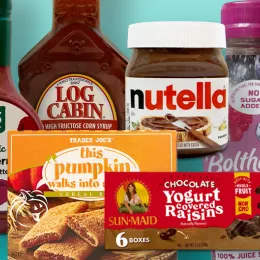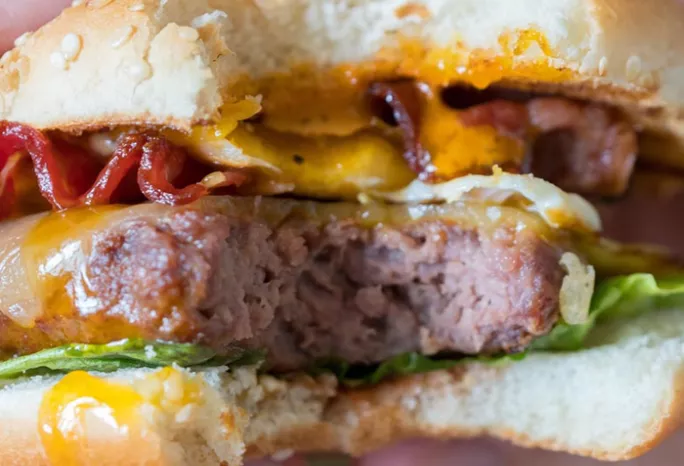The bad fats

Headlines occasionally suggest that some foods—coconut oil, high-fat dairy, and red meat—that are high in saturated fats are harmless or even healthful. Here’s why they’re not.
Coconut oil
Roughly 82 percent of the fat in coconut is saturated, yet it has a healthy reputation. What gives? Three common misconceptions about coconut oil have created confusion.
Misconception #1: Coconut oil’s saturated fats are harmless.

Some people claim that coconut oil’s saturated fat is harmless because the saturated fats are short chain.
“The evidence is straightforward,” says Frank Sacks, professor of cardiovascular disease prevention at the Harvard T.H. Chan School of Public Health. “Some of the short-chain saturated fatty acids in coconut oil don’t raise LDL cholesterol. But they don’t counteract the effects of the oil’s longer-chain fatty acids, which do increase LDL cholesterol. So coconut oil raises LDL cholesterol in the same way that, say, butter does.” (Roughly 65 percent of the fat in butter is saturated.)
Others claim that one of coconut oil’s key fats, lauric acid, is harmless because it’s a medium-chain fatty acid.
“Classifying lauric acid as a medium-chain fatty acid is a misnomer,” Sacks told the New York Times in 2021. “Rather than the number of carbon atoms in a fat,” he said, “what counts is how the fat is metabolized in the body. Lauric acid behaves like a long-chain fatty acid.” In other words, it raises LDL (“bad”) cholesterol.
Misconception #2: Coconut oil raises good cholesterol.
“Coconut oil contains natural saturated fats that increase HDL (good) cholesterol levels in your body,” says Healthline.com. But raising HDL may not matter.
“We’re no longer sure that raising HDL cholesterol lowers risk,” says fats expert Martijn Katan, of the Vrije Universiteit Amsterdam. “Drugs that raise HDL, for example, haven’t prevented heart attacks as we expected.”
So coconut oil, which raises both LDL and HDL, isn’t as heart-healthy as an oil like canola or soy, which lowers LDL and has little effect on HDL.
“Changes in HDL cholesterol caused by diet or drug treatments can no longer be directly linked to changes in CVD [cardiovascular disease],” says the American Heart Association. “Because coconut oil increases LDL cholesterol, a cause of CVD, and has no known offsetting favorable effects, we advise against the use of coconut oil.”
Misconception #3: Coconut oil’s medium-chain triglycerides lead to weight loss.

“‘The reason coconut oil is so popular for weight loss is partly due to my research on medium-chain triglycerides,’ Marie-Pierre St-Onge, associate professor of nutritional medicine at Columbia University Medical Center, told TIME in 2017.
For example, when St-Onge put 31 people who weighed an average of 180 pounds on a low-calorie diet for four months, those who got about 1½ teaspoons a day of medium-chain triglycerides (MCTs) lost 7 pounds, while those who got olive oil lost 3 pounds.
But St-Onge used a “designer oil” made only of MCTs. Coconut oil is only about 14 percent medium-chain fatty acids. In a recent study, men randomly assigned to consume a tablespoon a day of extra-virgin coconut oil for six weeks lost no more weight than those who consumed a tablespoon a day of soybean oil.
Which oils have less saturated fat than coconut?
All fats are a mix of saturated, monounsaturated, and polyunsaturated fatty acids (though people usually categorize each by the fatty acid that predominates). Odds are, you get mostly soybean oil in prepared foods (like salad dressings, mayonnaise, and margarine) and restaurant foods. So you’ll probably end up with a good mix of unsaturated fats if you use canola oil and olive oil (when you want its flavor) for cooking.

The bottom line: Coconut oil doesn’t deserve its health halo. Replace it with mostly unsaturated oils (like soybean, olive, and canola) and the healthy fats in nuts, avocado, fish, and soy foods.
High-fat dairy

“For the love of all that is dairy, why are we still eating low-fat?” asked Bon Appetit in 2018. “Science has come around on full-fat dairy. Why haven’t we listened?”
The science has come around, according to Bon Appetit, because “better designed studies found that saturated fat increased both good and bad cholesterol,” and “when both were raised, the net effect is zero.”
Wrong.
Four recent studies randomly assigned people to eat diets that were either high or low in saturated fat, largely from dairy. The results: LDL (bad) cholesterol was higher—and HDL (good) cholesterol didn’t budge—in people who ate more dairy fat.
“Dairy fat is high in palmitic acid, a saturated fat that has potent LDL-raising effects,” says Frank Hu, who chairs the nutrition department at the Harvard T.H. Chan School of Public Health.
And there’s no question that a higher LDL puts the heart at risk.
“LDL is a major cause of heart disease, and lowering it with diet or drugs prevents heart disease,” says Frank Sacks, professor of cardiovascular disease prevention at the Harvard T.H. Chan School of Public Health.
“LDL isn’t just a marker for a higher risk. It’s the real deal.”
Industry-funded studies

Dairy fat doesn’t raise LDL in some industry-funded studies, but there’s usually a reason why.
For example, one study—funded by the Australian, Canadian, Danish, Dutch, French, and U.S. dairy industries—reported no difference in LDL when people were randomly assigned to eat regular versus lower-fat cheese.
But the study was “underpowered”—that is, too small to see a difference from the change in sat fat—noted Jan Pedersen of the University of Oslo in a letter to the journal’s editor.
A second industry-funded study reported no higher LDL on a high-cheese or high-meat diet than on a lower-fat, higher-carb diet. No surprise there.
“The cheese and meat diets were enriched with foods rich in polyunsaturated fats such as nuts, canola oil, and sunflower oil, which are known to lower LDL cholesterol,” wrote Peter Marckmann of the Roskilde Hospital in Denmark in a letter to the editor.
“The diets were apparently designed so that the possibly desired conclusion could be drawn.”
Butter: worse than cheese

Butter may raise LDL slightly more than cheese.
In the largest study—funded by the Canadian dairy industry—LDL was 4 points higher when people ate about 10 pats of butter than when they ate about 3 ounces of cheese a day. (The two foods supplied the same amount of sat fat.)
However, the researchers reported much bigger differences in LDL when they switched people from butter to polyunsaturated fat (18 points lower), monounsaturated fat (10 points lower), or carbs (7 points lower).
“It’s conceivable that fermentation may mitigate the LDL-raising effect of the palmitic acid in cheese,” says Hu. “By how much, it’s hard to know.”
“But that doesn’t exonerate the palmitic acid and other saturated fats in cheese. It just means that when it comes to raising LDL, cheese is the lesser of two evils, and they’re both worse than unsaturated fats.”
That fits with studies that ask people what they eat and wait years to see who gets heart disease.
“There’s certainly no good evidence that high-fat dairy is better than low-fat,” says Hu. And pushing high-fat dairy could also lead to worse diets.
“We eat much of our dairy in foods like cheeseburgers and pizza,” notes Hu.
“Promoting high-fat dairy would do more harm than good because when we eat those foods, we get not only saturated dairy fat but also processed meats, refined carbs, and sodium.”
The bottom line
Dairy fat hasn’t earned a clean bill of health for your heart. Nor does high-fat dairy lower your risk of type 2 diabetes.
Red meat

Much of the fat in red meat—beef, pork, lamb, and veal—is saturated fat. So the meat industry has spent decades convincing consumers that beef and pork are lean.
“You might not have to give up (lean) red meat, after all,” reported the Washington Post in 2018. “Modest amounts of lean, unprocessed red meat don’t appear to have major health risks.”
The news: an industry-funded study found that, lo and behold, lean beef and pork don’t raise LDL (“bad”) cholesterol if they’re part of a “Mediterranean” diet! Gosh!
Only one catch: “Our results are not generalizable to all cuts of beef and pork because only tenderloins were provided to subjects,” wrote the authors. (That didn’t make the headlines.)
The beef industry has been funding studies using v-e-r-r-r-y lean meat since the 1990s. But those lean cuts account for only a small fraction of the beef we eat. What’s more, beef and pork may be fattier than you think. Here’s why:
The meat industry supplies USDA’s Nutrition Facts for meat.

Checking the calories, fat, etc. for fresh meat on a label, an app, or online? Most of those numbers come from USDA’s nutrient database. And where does the USDA get its numbers? Mostly from, or with funding from, the beef and pork industries. Hmm...
The USDA's database has numbers for beef that has had the fat around its edges trimmed down to just 1/8" or 0". (The pork industry never even says how much its cuts were trimmed.)
The USDA also has numbers for what's called "separable lean." That's after scalpel-wielding technicians trim off the "separable fat"—every bit of fat except marbling within the muscle.
All that trimming (where do you keep your scalpel?) helps explain how the beef industry's website can end up touting a few dozen cuts of "lean" beef. The list even includes fatty cuts like New York strip steak and brisket.
Apparently, if you're footing the bill, you get to make the rules.
70% lean isn’t lean.

Ground beef that’s labeled “70% lean” might sound low in fat. But with 30 percent fat, it’s the fattiest ground beef you can buy. And popular "80% lean" beef is still 20 percent fat.
Why don’t ground beef labels list only their percent fat? Because also listing percent lean makes the meat sound, well, lean.
Don’t confuse “lean” with “low-fat.”
“Lean” meat has no more than 4½ grams of saturated fat per 4 oz. (raw) serving. It’s no skinless chicken breast. Only “extra lean” meat (2 grams of sat fat, max) is in skinless chicken or turkey territory.
(With fish, the more fat, the merrier. Fatty fish, like salmon, are rich in unsaturated, heart-healthy fat.)
Bad fats aside, even lean red meat may boost the risk of heart disease and cancer.
Photos: Tijana Drndarski/unsplash.com (coconut), StockSnap/pixabay.com (cheese), Olivier Le Moal/stock.adobe.com (scale).
The Latest by Bonnie
A snapshot of the latest research on diet, exercise, and more
Weight and Health

Prediabetes: What may—and may not—help reverse it?
Weight and Health

A snapshot of the latest research on diet, exercise, and more
Preventing Disease

The good fats
Healthy Eating

Play the ingredient game!
Food Labeling

More on meat and dairy

Subscribe to Nutrition Action
We name names, remain strictly objective, and deliver scrupulously researched advice about food of all kinds, staying healthy with diet and exercise, and more.




